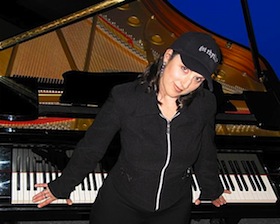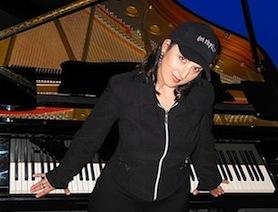
“I heard her at a jazz camp a couple of weeks ago and was blown away,” said Dan Zinn, the noted Bay Area saxophonist and teacher, talking about the 16-year-old guitarist Simone Boszormenyi. She was about to audition for the SFJAZZ All-Stars on a recent Sunday in the chilly band room at San Francisco School of the Arts. Zinn, one of the adjudicating pros, expected to hear great things again.
He wasn’t disappointed. Boszormenyi, who attends the private Bentley School in Lafayette, spun out a half dozen fresh and swinging choruses on the Charlie Parker blues Billie’s Bounce, played a lyrical version of the Jerome Kern classic All the Things You Are, and sight read passages from a big band chart of Herbie Hancock’s Driftin’. Rebeca Mauleón, SFJAZZ’s education director and a prime Latin jazz pianist, sat down at the keyboard, banged out a rocking Afro-Cuban vamp, or montuno, and asked the guitarist to play around it. Boszormenyi responded with syncopated staccato phrases that made the music pop.
Featured Video
“The girl’s got personality,” Mauleón said after the guitarist had left the room. “I heard her play with the Latin Youth Orchestra and she took a great solo. She has great stage presence. She’s willing to play everything. It’s looking good for her.”
Zinn nodded in agreement. “She’s got good reharmonization, she plays good lines, good double time and triplets, and the lines all made sense together. She’s a player,” the saxophonist raved. He directs the eight-piece combo that complements the SFJAZZ High School All-Stars big band, an award-winning ensemble that draws the most gifted young jazzers from around the Bay Area.
The band is a centerpiece of the SFJAZZ’s expanding education program, which puts on free clinics and workshops for high school musicians and brings artists into San Francisco middle schools to relate the history of jazz, and its democratic nature, to classroom curricula: language arts, African and American history. The musicians give lecture-demonstrations and perform.
“The majority of public schools have no music at all. We want to put instruments in kids’ hands and get them playing.” – Rebeca Mauleón
For the first time this semester, the Jazz in the Middle program is sending clinicians into a handful of middle schools that have band programs to teach kids the jazz language and how to improvise. It’s a pilot program that Mauleón — who has big plans for the entire education program when SFJAZZ moves into the $50 million center it’s building at the corner of Fell and Franklin streets — hopes to expand next year.
Feeder Program
The goal of the new middle-school performance initiative “is to get kids up to speed so they can feed into our high school program,” said Mauleón, a lively woman who was wearing an SFJAZZ baseball cap and praising every kid who auditioned, however well they played. “We want to develop more outreach, free clinics, and workshops for middle school kids to learn the jazz vernacular from the great teaching artists we have in the community, and from stars who come through as part of the SFJAZZ season.”
A professor of music at City College of San Francisco, where she teaches composition, Latin American music, and Latin jazz piano, Mauleón has performed with many celebrated musicians, among them Carlos Santana, Tito Puente, and Stevie Winwood. Her first orchestral composition, an Afro-Cuban suite, was commissioned and performed by the Oakland East Bay Symphony last year. She took the education job at SFJAZZ with the intention of broadening the program’s reach and bringing jazz to schools that can’t afford any music.
“The majority of public schools have no music at all,” Mauleón said. “We want to put instruments in kids’ hands and get them playing. We want to develop an instrument loan program.”
Her ability to do that will depend, of course, on getting financial support. But SFJAZZ has done extraordinarily well in the fund-raising department. A little more than a year before the Mark Cavagnero–designed SFJAZZ Center is expected to open, the organization is close to reaching its $60 million capital campaign goal.
“When I’m playing, I try not to think about the pressure and just read the music and play my instrument.” – Adeyemi Demitrius
Among other things, the new center will provide a permanent home for the SFJAZZ High School All-Stars, whose members will lead jam sessions for musicians who are too young to get into clubs. A new big band will be started for older teens and adults, who can also take theory classes in the new building and get training in digital recording and sequencing.
Formed a decade ago, the high school band has become a springboard for a slew of talented musicians. Recent alumni include alto saxophonist and flutist Jill Ryan, a graduate of Marin School of the Arts who’s on full music scholarship at the New School in New York; saxophonist Robbie Sheppard, who won a full scholarship to University of Southern California; trombonist Jon Hatamiya, who drove down from Davis once a week to rehearse and is now at the Manhattan School of Music; and drummer Malachi Witson, a Richmond kid who was able to buy his instrument and get lessons with the help of SFJAZZ benefactors. He just started at the Brubeck Jazz Institute at the University of the Pacific.
“We’ve had some fantastic players,” said Paul Contos, a noted saxophonist, teacher, and clinician who’s on the music faculty at California State University, Monterey Bay, and is the longtime director of the SFJAZZ high school band. “Some of them are really playing at a professional level.”
Schools Fall Short on Classical Training
Listening to the 70 or so who auditioned over a three-day period this month, the adjudicators — Contos, Mauleón, veteran drummer Vince Lateano, and trombonist Dave Martell — rated the musicians on their technique, musicality, improvisation, and sight reading. Sight reading is where many young jazz players fall short. They don’t get enough classical training in the schools.
“You have to have a complete foundation,” Mauleón said.
Many of the kids who come through the band attend private schools and come from families that can afford to give them private lessons. Aiming to give more students access to one-on-one instruction, SFJAZZ started sending clinicians to School of the Arts (SOTA) this semester to work with the students in Melecio Magadaluyo’s jazz and Latin ensembles.
Trombonist Adeyemi Demetrius is a SOTA senior who played in the SFJAZZ band last year. He’d let this year’s audition slip his mind and hadn’t prepared anything, he told the judges apologetically. But he did a good job winging it. Reading from a jazz “fake” book, he played the Charlie Parker bebop blues Au Privave and the standard All of Me.
“How’s your low range? I heard you play a nice big fat low F,” said Martell, who asked Demetrius to play chromatically from low B-flat down to E.
“I know a good tone when I hear it,” said Mauleón, who praised the kid’s sight reading, but urged him to really focus on reading syncopation. Stepping outside after his audition, Demetrius reflected on his performance.
“I was pretty nervous, because my mom just told me I had an audition today,” he said. “But when I’m playing, I try not to think about the pressure and just read the music and play my instrument. Some of the sight reading was sketchy, but I think I did all right. My tone was there. I’ve been working on it and it’s getting better.”
The pleasure of playing with this all-star band, he went on, “is that you’re with a bunch of kids who are really on top of their music. They’re on that next level and willing to put the work in. You get to play really complex pieces. Last year we got to go to New Orleans, play all these great gigs, and meet great musicians. Why wouldn’t you want to do it?”

